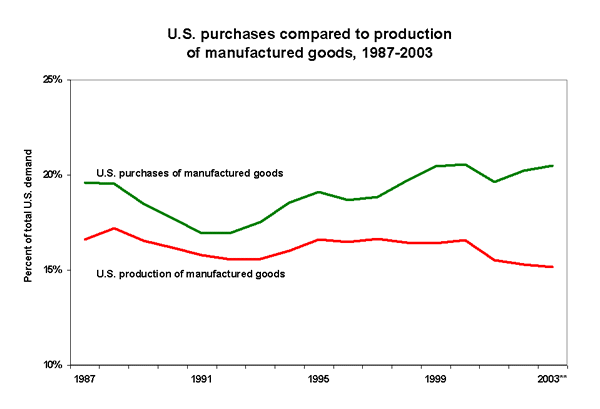See Snapshots Archive.
Snapshot for March 10, 2004.
Lack of domestic demand is not the cause of manufacturing’s woes
The U.S. manufacturing industry ended 2003 with fewer workers than at any time since 1958, and employment in this sector has fallen by more than three million since 1998. Despite these losses, many economists—including those at the Congressional Budget Office (CBO)*—have asserted that international trade is not a prime contributor to this employment loss. Instead, these economists have hypothesized that domestic factors have led to manufacturing’s decline. Chief among these factors cited is declining demand for manufacturing output on the part of U.S. consumers.
At the center of the argument that domestic factors are driving manufacturing’s decline is the assertion that as U.S. consumers get richer, they choose to spend additional income on services, not manufactured goods. However, the figure below shows this to be untrue. Demand for manufacturing output has actually risen in the past 10 years, and rising trade deficits in the manufacturing sector have been the primary cause of falling production in the United States. These deficits have led to a decline in the share of domestic demand that is satisfied by domestic output. As illustrated in the figure, U.S. production of manufacturing goods declined between 1987 and 2003, despite the strengthening consumer demand.**

The gap between purchases and output is “net imports.” Net manufacturing imports reached 5% of total U.S. gross domestic product in 2003, indicating that more and more demand for manufactured goods is being satisfied by international imports, while export growth has lagged. Closing the net imports gap is the single most powerful economic lever available to solve the manufacturing job crisis.
* See the recent CBO report, “What accounts for the decline in manufacturing employment?”
** Domestic manufacturing output data from the Bureau of Economic Analysis (BEA) GDP by industry program. Data for 1987-2002 and 2003 data for total GDP, exports, and imports are from the BEA and Census Bureau. Manufacturing output for 2003 is projected using past relationships between manufacturing output and total GDP growth. Domestic manufacturing purchases are calculated as domestic manufacturing output plus manufacturing imports minus manufacturing exports.
This week’s snapshot was written by EPI economist Josh Bivens.
